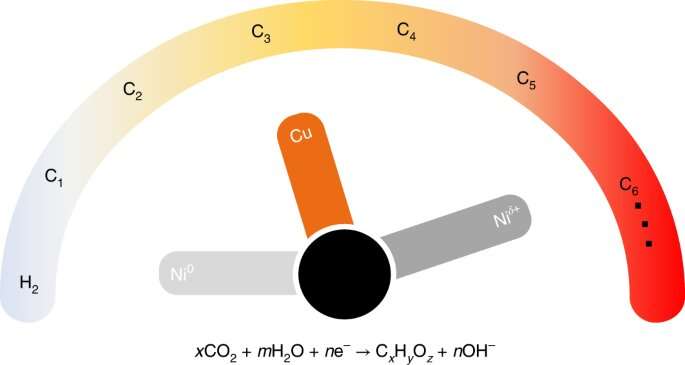Credit: Nature Catalysis (2022). DOI: 10.1038/s41929-022-00803-5
A team of researchers from ETH Zurich, the National University of Singapore and the Institute of Chemical Research of Catalonia, has found that it is possible to use nickel-containing catalysts to produce multi-carbon products. In their paper published in the journal Nature Catalysis, the group describes the ways they tested the idea of using nickel-containing catalysts to produce hydrocarbons from carbon dioxide and what they learned by doing so.
As the world grows ever warmer due to the inability of humans across the planet to reduce greenhouse gas emissions, scientists continue to look for ways to reduce the reliance on refined oil. In this new effort, the researchers looked at the possibility of using the results of research conducted 30 years ago that involved the use of metallic nickel to reduce carbon dioxide when making hydrocarbons that could be used as a clean type of fuel.
As the researchers note, a lot of work has been done looking at ways to use copper as an electrocatalyst to convert carbon dioxide to hydrocarbons. Unfortunately, thus far, such efforts have not led to applications that could be scaled to industrial applications. In this new effort, the researchers took a new look at theoretical work done by a team back in the 1990s—they had described a process that involved the use of nickel instead of copper to produce hydrocarbons using pressurized carbon dioxide.
To find out if the theory would work in the real world, the researchers devised a series of experiments to test them. The first involved using metallic nickel disks and resulted in the production of very little hydrocarbon material. Another involved changing the disks using electrochemical passivation to create NiO5—doing so doubled the amount of hydrocarbon produced; a good result, but not enough to suggest it could be used in real world applications. The researchers then tested inorganic nickel oxygenate catalysts and found that all of them could be used to produce hydrocarbons—the best had efficiencies up to 6.5%.
The researchers suggest their results indicate that catalysts made using nickel should be considered more strongly as possible candidates for use in the creation of hydrocarbons in the search for new ways to create greener fuels.
More information: Yansong Zhou et al, Long-chain hydrocarbons by CO2 electroreduction using polarized nickel catalysts, Nature Catalysis (2022). DOI: 10.1038/s41929-022-00803-5
Journal information: Nature Catalysis
© 2022 Science X Network
























